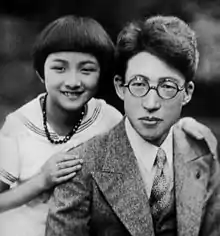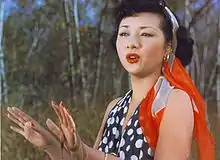Hideko Takamine
Hideko Takamine (高峰 秀子, Takamine Hideko, March 27, 1924 – December 28, 2010) was a Japanese actress who began as a child actress and maintained her fame in a career that spanned 50 years. She is particularly known for her collaborations with directors Mikio Naruse and Keisuke Kinoshita, with Twenty-Four Eyes (1954) and Floating Clouds (1955) being among her most noted films.[2][3][4]
Hideko Takamine | |
|---|---|
 Hideko Takamine in the late 1940s | |
| Born | Hideko Hirayama[1] March 27, 1924 Hakodate, Hokkaido, Japan |
| Died | December 28, 2010 (aged 86) Tokyo, Japan |
| Nationality | Japanese |
| Occupation | Actress |
| Years active | 1929–1979 |
| Spouse | |
Biography

Takamine was born in Hakodate, Hokkaidō, in 1924. At the age of four, following the death of her mother, she was placed in the care of her aunt in Tokyo. Her first role was in the Shochiku studio's 1929 film Mother (Haha), which brought her tremendous popularity as a child actor.[2] Many of the films of her early career were imitations of Shirley Temple films.[5]
After moving to the Toho studio in 1937, her dramatic roles in Kajirō Yamamoto's Tsuzurikata kyōshitsu (1938) and Horse (1941) brought her added fame as a girl star.[2] She toured as a singer to entertain Japanese troops and, after the war, sang for American occupation troops in Tokyo.[2] After initially appearing in a pro-union film, Those Who Make Tomorrow (1946), she became appalled by the rigid practices of the union's leaders and members and, during the post-war strikes at Toho, first joined a new union before moving to the new Shintoho studios in 1947.[6]
In 1950, she left Shintoho and became a freelance actress.[2] Her films with directors Keisuke Kinoshita and Mikio Naruse during the 1950s made her Japan's top star. Notable films of this decade include Kinoshita's satirical comedy Carmen Comes Home (1951), Japan's first feature length colour film, and the antiwar drama Twenty-Four Eyes (1954), and Naruse's Floating Clouds (1955) and When a Woman Ascends the Stairs (1960).[2]
She was especially favoured as leading actress by Naruse, appearing in 17 of his films between 1941 and 1966, which are considered "some of her finest performances" (Jasper Sharp),[7] with her "sensitive yet resourceful persona" proving ideal for "Naruse's suffering, persevering heroines" (Alexander Jacoby).[8] Film historian Donald Richie described the characters she portrayed as follows: "Like so many Japanese women then, they wanted more out of life, but couldn’t get it. The war may have been over, women found, but they weren’t better off. They were still fairly unhappy. So the kind of roles Takamine played fit the zeitgeist, may have even made that zeitgeist." Comparing Naruse and Kinoshita, Takamine explained: "Though different in style, they shared a common aversion to things that were not natural. What I tried to do was to be as natural as women we see in the news, but adding a touch of drama so that I would be even more real."[2]
She married writer-director Zenzo Matsuyama in 1955,[2] but continued her acting career, stating that she wanted to "create a new style of wife who has a job".[3] After retiring as an actress in 1979, she published her autobiography and several essay collections.[9] She died of lung cancer on 28 December 2010 at the age of 86.[2]
Selected filmography

From left to right, Tokihiko Okada, Hideo Sugawara and Hideko


| Year | Title | Role | Director(s) | Notes |
|---|---|---|---|---|
| 1929 | Mother | Hōtei Nomura | Film debut | |
| 1931 | Tokyo Chorus | Yasujirō Ozu | ||
| 1938 | Tsuzurikata kyōshitsu | Kajirō Yamamoto | ||
| Niji tatsu oka | Yuri | Toshio Ōtani | ||
| 1941 | Hideko the Bus Conductor | Okoma | Mikio Naruse | First film with Naruse |
| Horse | Kajirō Yamamoto | |||
| 1943 | Ahen senso | Masahiro Makino | ||
| 1946 | Those Who Make Tomorrow | Takamine | Akira Kurosawa Hideo Sekigawa Kajirō Yamamoto |
|
| Aru yo no tonosama | Teinosuke Kinugasa | |||
| 1949 | Ginza kankan musume | Koji Shima | ||
| 1950 | The Munekata Sisters | Yasujirō Ozu | ||
| 1951 | Carmen Comes Home | Okin alias Lily Carmen | Keisuke Kinoshita | First film with Kinoshita |
| 1952 | Lightning | Mikio Naruse | ||
| Carmen's Pure Love | Carmen | Keisuke Kinoshita | ||
| 1953 | Where Chimneys Are Seen | Heinosuke Gosho | ||
| The Wild Geese | Otama | Shirō Toyoda | ||
| 1954 | The Garden of Women | Yoshie Izushi | Keisuke Kinoshita | |
| Twenty-Four Eyes | Hisako Ōishi | Keisuke Kinoshita | ||
| Somewhere Beneath the Wide Sky | Masaki Kobayashi | |||
| 1955 | Floating Clouds | Mikio Naruse | ||
| 1956 | Nagareru | Mikio Naruse | ||
| A Wife's Heart | Mikio Naruse | |||
| 1957 | Untamed | Mikio Naruse | ||
| Times of Joy and Sorrow | Kiyoko Arisawa | Keisuke Kinoshita | ||
| 1958 | Rickshaw Man | Yoshiko Yoshioka | Hiroshi Inagaki | |
| 1960 | When a Woman Ascends the Stairs | Keiko Yashiro | Mikio Naruse | |
| Daughters, Wives and a Mother | Mikio Naruse | |||
| The River Fuefuki | Okei | Keisuke Kinoshita | ||
| 1961 | As a Wife, As a Woman | Miho Nishigaki | Mikio Naruse | |
| Happiness of Us Alone | Akiko Katayama | Zenzo Matsuyama | ||
| The Human Condition: A Soldier's Prayer | Masaki Kobayashi | |||
| Immortal Love | Keisuke Kinoshita | |||
| 1962 | Burari bura-bura monogatari | Zenzo Matsuyama | ||
| A Wanderer's Notebook | Mikio Naruse | |||
| 1963 | A Woman's Story | Mikio Naruse | ||
| 1964 | Yearning | Reiko Morita | Mikio Naruse | |
| 1967 | The Doctor's Wife | Yasuzo Masumura | ||
| 1973 | The Twilight Years | Shirō Toyoda | ||
| 1979 | Oh, My Son! | Keisuke Kinoshita | Final film | |
Awards
- 1996 Lifetime Achievement Award
Mainichi Film Concours for Best Actress
- 1955 Twenty-Four Eyes, Garden of Women, Somewhere Beneath the Wide Sky
- 1956 Floating Clouds
- 1958 Times of Joy and Sorrow, Untamed
- 1962 Immortal Love, Happiness of Us Alone
Blue Ribbon Award for Best Actress
- 1955 Twenty-Four Eyes, Garden of Women, Somewhere Beneath the Wide Sky
Kinema Junpo Award for Best Actress
- 1956 Floating Clouds
References
- "People of 2010: Obituaries". Encyclopaedia Britannica: Book of the year 2011. Encyclopaedia Britannica, Inc. 2011. p. 160. ISBN 978-1-61535-500-6.
- McLellan, Dennis (1 January 2011). "Actress Hideko Takamine dies at age 86". Los Angeles Times. Retrieved 21 March 2012.
- Johnson, G. Allen (December 28, 2005). "Director Mikio Naruse retrospective takes insightful plunge into a postwar Japan in flux". San Francisco Chronicle. Retrieved February 15, 2021.
- Kirkup, James (11 October 2017). "Tears and Laughter: Women in Japanese Melodrama". electric-shadows.com. Retrieved February 15, 2021.
- Anderson, Joseph L.; Richie, Donald (1959). The Japanese Film – Art & Industry. Rutland, Vermont and Tokyo: Charles E. Tuttle Company.
- Hirano, Kyoko (1992). Mr. Smith Goes to Tokyo: Japanese Cinema Under the American Occupation, 1945–1952. Washington and London: Smithsonian Institution Press. ISBN 1-56098-157-1.
- Sharp, Jasper (2011). Historical Dictionary of Japanese Cinema. Lanham, Toronto, Plymouth: Scarecrow Press. ISBN 978-0-8108-5795-7.
- Jacoby, Alexander (2008). Critical Handbook of Japanese Film Directors: From the Silent Era to the Present Day. Berkeley: Stone Bridge Press. ISBN 978-1-933330-53-2.
- Kehr, Dave (3 January 2011). "Hideko Takamine, Lauded Japanese Actress, Dies at 86". New York Times. Retrieved 21 March 2012.
External links
- Hideko Takamine at IMDb
- Hideko Takamine at the Japanese Movie Database (in Japanese)
- Birnbaum, Phyllis (29 October 1990). "Profiles: The odor of pickled radishes". The New Yorker. p. 53. Retrieved 15 February 2021.